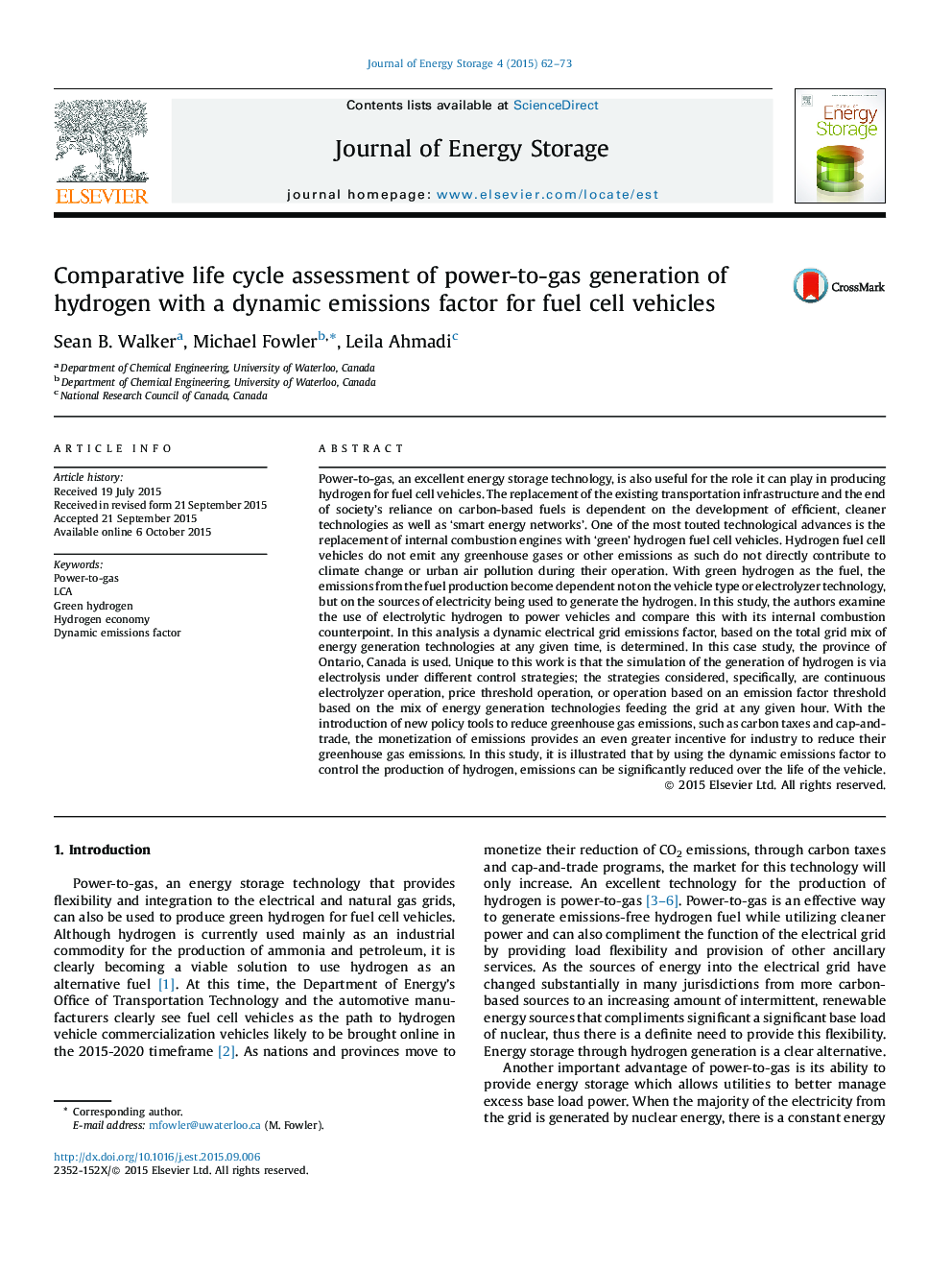| کد مقاله | کد نشریه | سال انتشار | مقاله انگلیسی | نسخه تمام متن |
|---|---|---|---|---|
| 7540473 | 1489018 | 2015 | 12 صفحه PDF | دانلود رایگان |
عنوان انگلیسی مقاله ISI
Comparative life cycle assessment of power-to-gas generation of hydrogen with a dynamic emissions factor for fuel cell vehicles
ترجمه فارسی عنوان
ارزیابی چرخه زندگی مقایسه ای از تولید انرژی هیدروژن با یک عامل انتشار پویا برای وسایل نقلیه سوخت
دانلود مقاله + سفارش ترجمه
دانلود مقاله ISI انگلیسی
رایگان برای ایرانیان
کلمات کلیدی
ترجمه چکیده
انرژی به گاز، یک فناوری ذخیره انرژی عالی، برای نقش آن در تولید هیدروژن برای وسایل نقلیه سوخت نیز مفید است. جایگزینی زیرساخت های حمل و نقل موجود و پایان وابستگی جامعه به سوخت های کربن وابسته به توسعه فن آوری های کارآمد، پاکیزه و همچنین شبکه های هوشمند انرژی است. یکی از پیشرفته ترین فن آوری های پیشرفته، جایگزینی موتورهای احتراق داخلی با وسایل نقلیه سلول سوختی سبز است. وسایل نقلیه سلول سوخت هیدروژن گازهای گلخانه ای را انتشار نمی دهند و یا انتشار های دیگر به طور مستقیم به تغییرات اقلیمی و یا آلودگی هوای شهری در طول عملیات آنها کمک نمی کند. هیدروژن سبز به عنوان سوخت، انتشار گازهای گلخانه ای از تولید سوخت وابسته به نوع خودرو یا تکنولوژی الکترولیز نیست، بلکه در منابع الکتریسیته مورد استفاده برای تولید هیدروژن است. در این مطالعه، نویسندگان بررسی استفاده از هیدروژن الکترولیتی را برای وسایل نقلیه قدرت و مقایسه آن با مقادیر داخلی احتراق آن می سنجند. در این تجزیه و تحلیل، یک فاکتور انتشار گاز پویای دینامیکی، بر اساس مجموع ترکیب شبکه از فن آوری های تولید انرژی در هر زمان مشخص، تعیین می شود. در این مورد مورد استفاده، استان انتاریو، کانادا استفاده می شود. منحصر به این کار این است که شبیه سازی تولید هیدروژن از طریق الکترولیز تحت استراتژی های کنترل متفاوت است؛ استراتژی هایی که به طور خاص مورد بررسی قرار می گیرند عبارتند از: عملیات الکترولیز پیوسته، عملیات آستانه قیمت یا عملیات بر اساس یک آستانه فاکتور خروجی بر اساس ترکیبی از فن آوری های تولید انرژی که به شبکه در هر ساعت داده می شود. با معرفی ابزارهای سیاست جدید برای کاهش انتشار گازهای گلخانه ای، مانند مالیات های کربن و سرمایه و تجارت، کسب درآمد از انتشار گازهای گلخانه ای باعث ایجاد انگیزه بیشتر برای صنعت برای کاهش انتشار گازهای گلخانه ای می شود. در این مطالعه، نشان داده شده است که با استفاده از عامل انتشار پویا برای کنترل تولید هیدروژن، انتشار در طول عمر وسیله نقلیه می تواند به طور قابل توجهی کاهش یابد.
موضوعات مرتبط
مهندسی و علوم پایه
مهندسی انرژی
انرژی (عمومی)
چکیده انگلیسی
Power-to-gas, an excellent energy storage technology, is also useful for the role it can play in producing hydrogen for fuel cell vehicles. The replacement of the existing transportation infrastructure and the end of society's reliance on carbon-based fuels is dependent on the development of efficient, cleaner technologies as well as 'smart energy networks'. One of the most touted technological advances is the replacement of internal combustion engines with 'green' hydrogen fuel cell vehicles. Hydrogen fuel cell vehicles do not emit any greenhouse gases or other emissions as such do not directly contribute to climate change or urban air pollution during their operation. With green hydrogen as the fuel, the emissions from the fuel production become dependent not on the vehicle type or electrolyzer technology, but on the sources of electricity being used to generate the hydrogen. In this study, the authors examine the use of electrolytic hydrogen to power vehicles and compare this with its internal combustion counterpoint. In this analysis a dynamic electrical grid emissions factor, based on the total grid mix of energy generation technologies at any given time, is determined. In this case study, the province of Ontario, Canada is used. Unique to this work is that the simulation of the generation of hydrogen is via electrolysis under different control strategies; the strategies considered, specifically, are continuous electrolyzer operation, price threshold operation, or operation based on an emission factor threshold based on the mix of energy generation technologies feeding the grid at any given hour. With the introduction of new policy tools to reduce greenhouse gas emissions, such as carbon taxes and cap-and-trade, the monetization of emissions provides an even greater incentive for industry to reduce their greenhouse gas emissions. In this study, it is illustrated that by using the dynamic emissions factor to control the production of hydrogen, emissions can be significantly reduced over the life of the vehicle.
ناشر
Database: Elsevier - ScienceDirect (ساینس دایرکت)
Journal: Journal of Energy Storage - Volume 4, December 2015, Pages 62-73
Journal: Journal of Energy Storage - Volume 4, December 2015, Pages 62-73
نویسندگان
Sean B. Walker, Michael Fowler, Leila Ahmadi,
